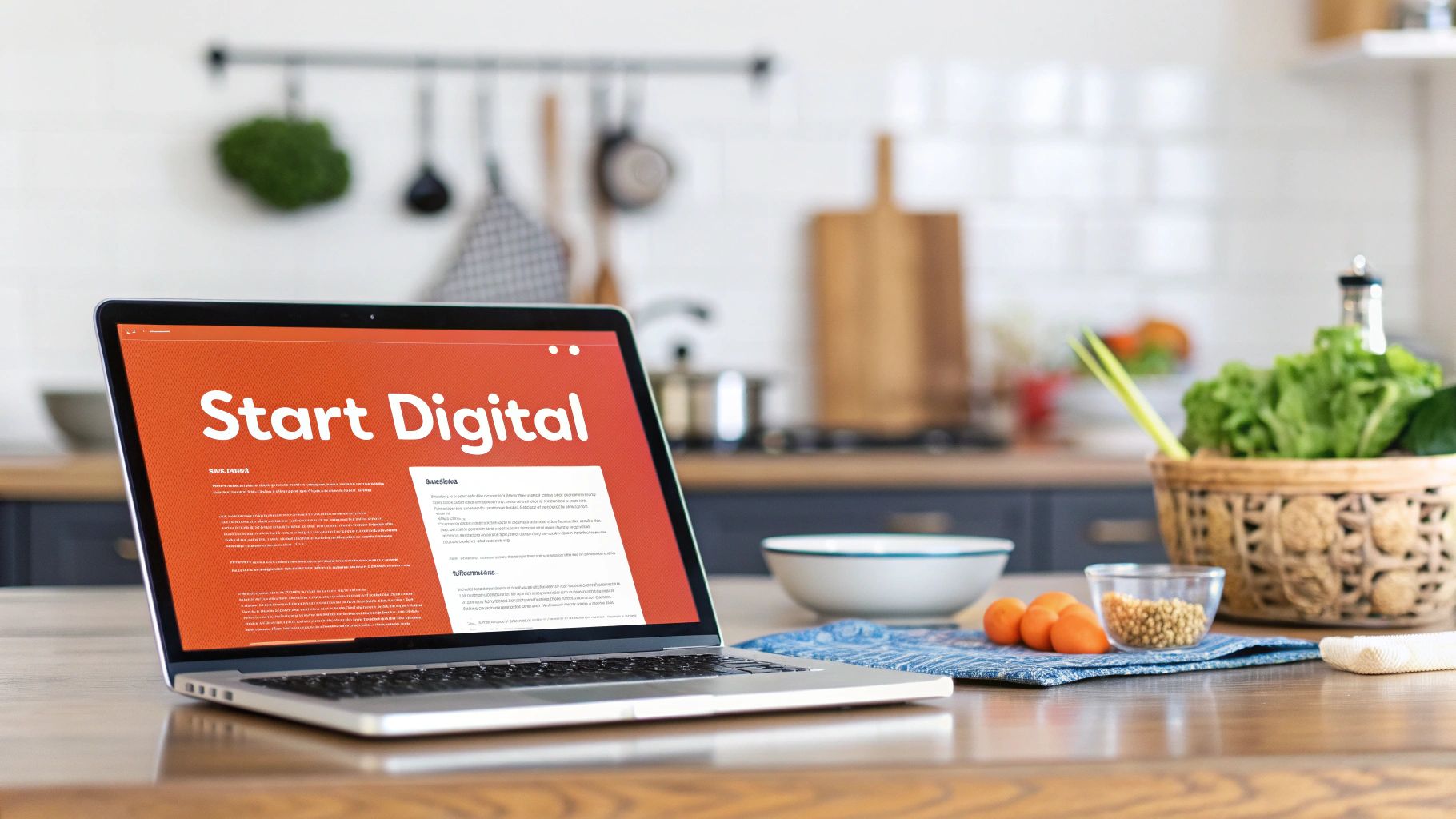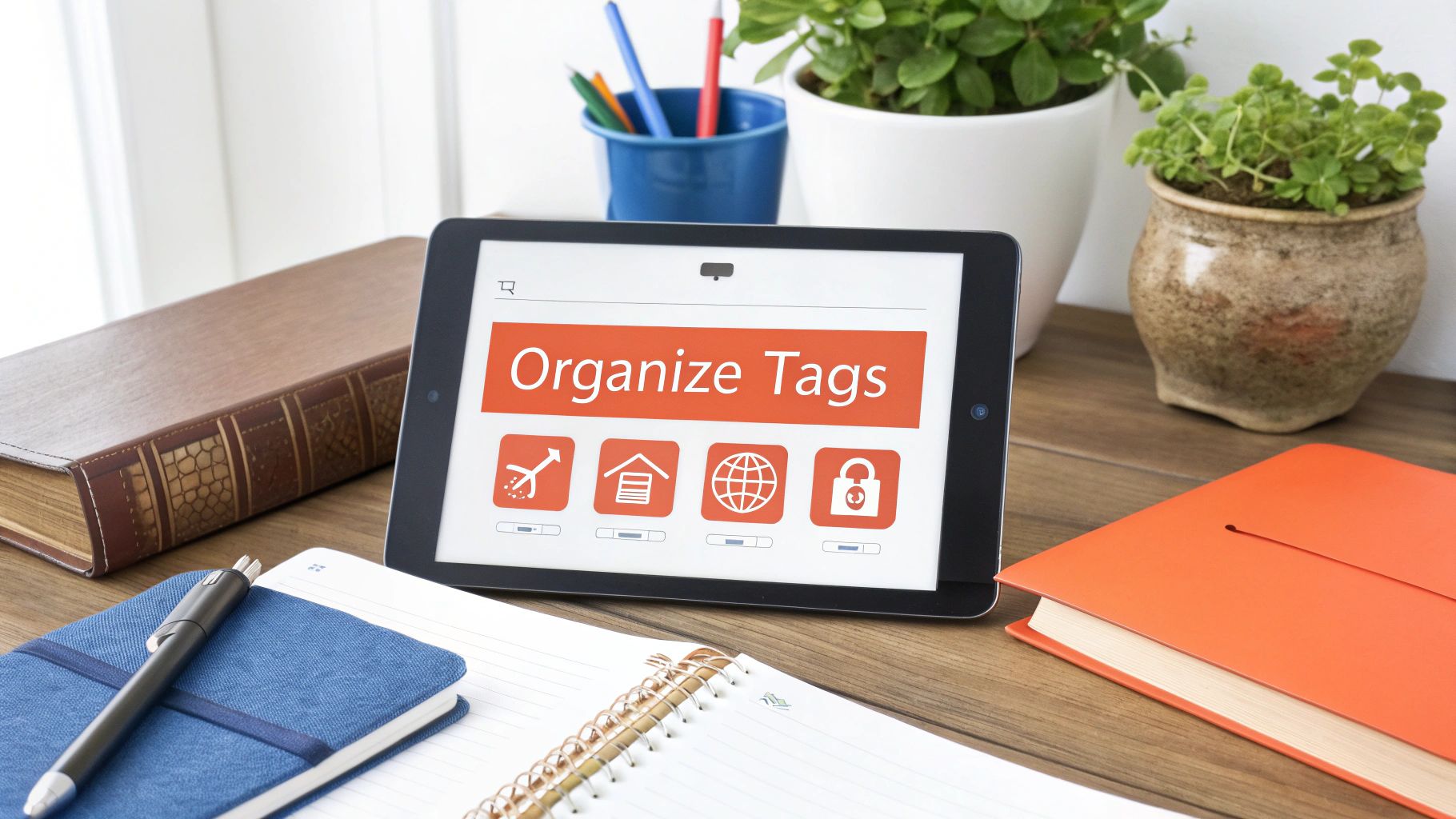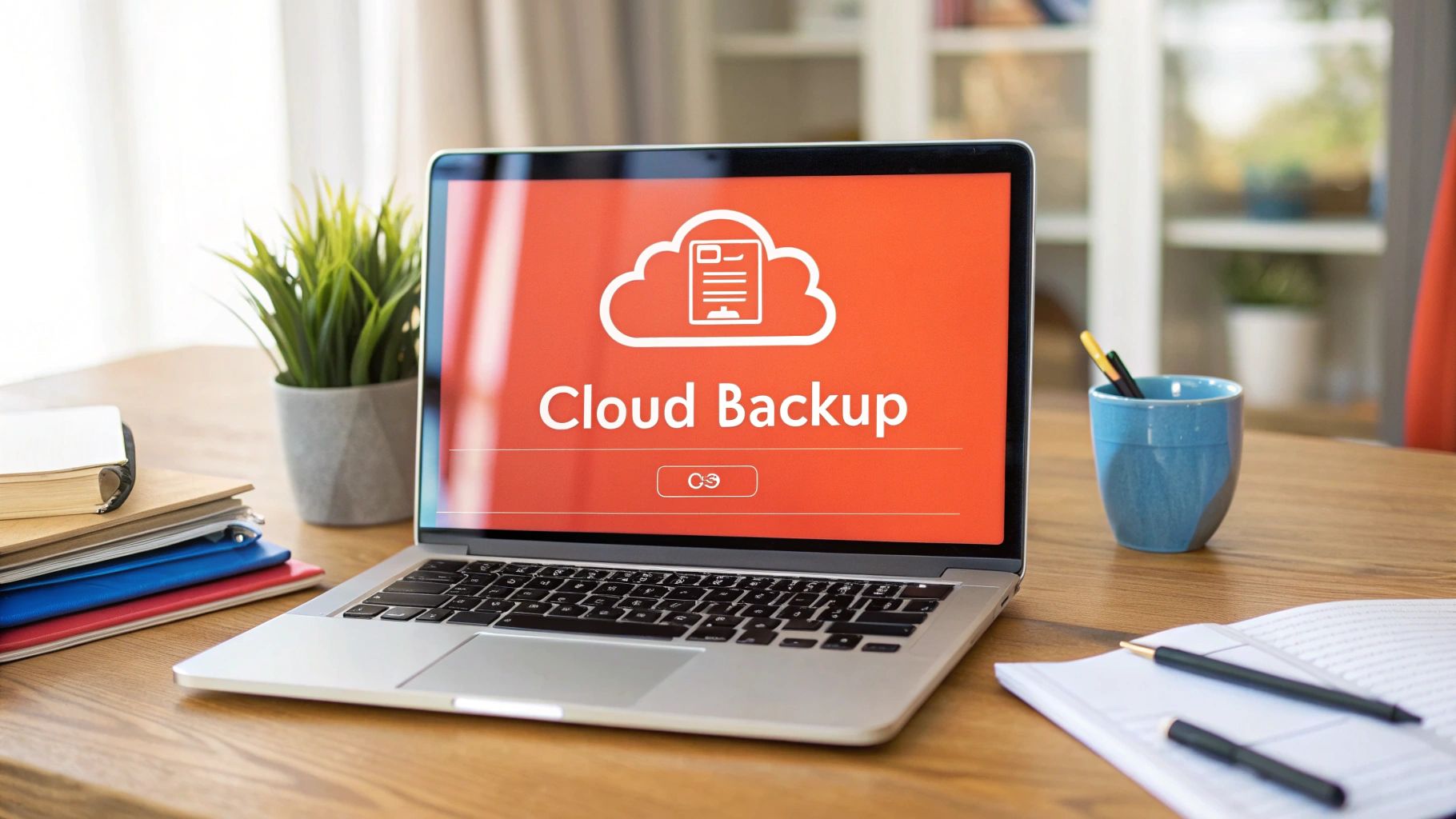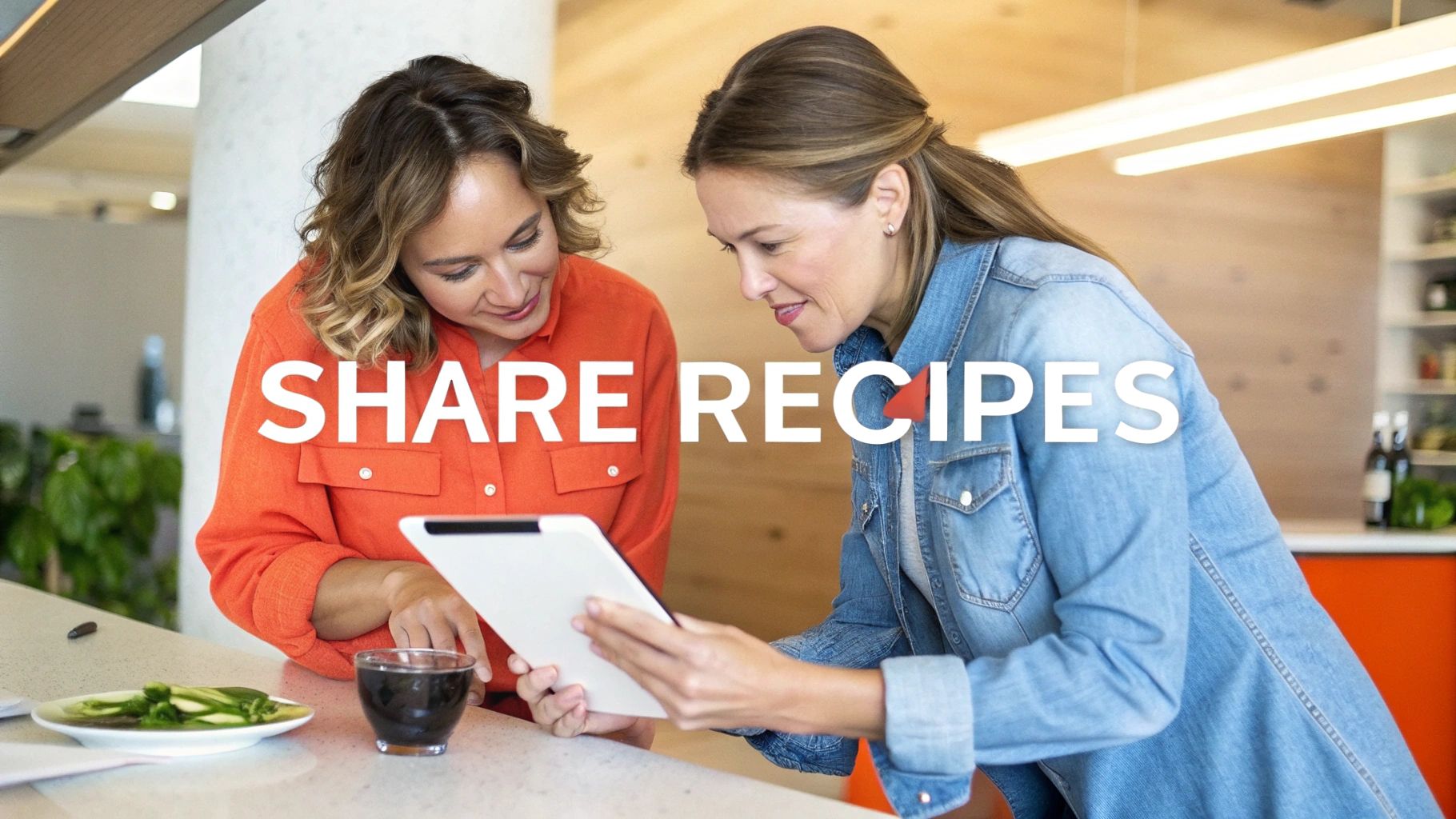The Digital Revolution Transforming Home Cooking

Remember sifting through stained recipe cards or bulky cookbooks? Today, managing recipes is evolving. The question of how to organize recipes digitally is becoming increasingly common, reflecting a significant shift in kitchen habits. We're no longer limited by physical space or messy handwriting. This transition offers a major improvement to the cooking experience.
Imagine instantly accessing any recipe on your phone or tablet. Digital organization makes this a reality. Searching for a specific dish becomes easy with keyword searches, unlike flipping through countless pages. This allows you to spend less time searching and more time cooking.
This shift toward digital recipe management is more than just a trend. The growth of the digital recipe consumption market over the past decade underscores this change. This market was valued at USD 625.91 million in 2024. It's projected to reach USD 1,706.30 million by 2031, demonstrating a CAGR of 15.40%.
Several factors are driving this growth. These include technological advancements, increased smartphone accessibility, and improved internet connectivity. These factors have made it much easier for users to find and access recipes instantly. Learn more about this growing market here: Digital Recipe Consumption Market
Key Benefits of Digital Recipe Organization
Beyond simple convenience, digitally organizing recipes offers several key advantages:
- Effortless Scaling: Adjust serving sizes with a few taps, eliminating complex calculations.
- Nutritional Information at Your Fingertips: Easily review the nutritional content of your dishes.
- Ingredient Filtering: Find recipes based on available ingredients or dietary restrictions.
- Cloud Storage and Backup: Secure your recipes in the cloud, protecting them from loss or damage.
- Seamless Sharing: Share your favorite recipes with friends and family with ease.
The Future of Cooking Is Digital
These features, impossible with traditional methods, showcase how digital recipe organization is changing how we cook. It's not just about convenience. It's about efficiency, creativity, and more control in the kitchen. By using digital tools, you can discover a wider range of culinary possibilities and significantly improve your cooking experience.
Choosing The Right Digital Tools For Your Cooking Style
Not all recipe apps are created equal. What works for a seasoned chef might not suit a busy parent planning family dinners. Finding the right digital tools depends on your cooking style, technical comfort, and organizational preferences. This means understanding the differences between dedicated recipe managers and general-purpose tools.
Dedicated Recipe Managers Vs. General-Purpose Tools
Dedicated recipe managers like Paprika and Whisk offer specialized features for cooks. These often include automatic shopping list generation, meal planning capabilities, and nutritional analysis. Paprika, for instance, lets you clip recipes directly from websites, saving you valuable time. Whisk excels at suggesting recipes based on ingredients you have on hand.
However, general-purpose tools like Evernote and Google Drive also have a place in the digital kitchen. These platforms may lack specialized cooking features, but their flexibility allows customization. You might find this helpful: Our guide on the best ways to organize recipes. Plus, they often integrate well with other apps you already use, simplifying your digital life.
This increasing shift towards digital recipe organization reflects broader trends. The recipe app market, valued at USD 724.4 million in 2024, is projected to reach USD 2,268 million by 2033, a CAGR of 13.5%. Free apps currently hold a dominant 73.6% market share. This growth stems from rising health awareness and the demand for convenient meal planning. For more detailed statistics, check out this report: Recipe App Market Growth.

Evaluating Your Needs and Choosing the Right Fit
Choosing the right tool depends on your personal needs. Consider these questions:
-
How tech-savvy am I? A dedicated recipe manager with advanced features suits tech-comfortable users. If you prefer simplicity, a basic note-taking app might suffice.
-
What are my biggest recipe organization challenges? Do you lose recipes often? Struggle with meal planning? Identifying your pain points helps you choose a tool that addresses those issues.
-
What other digital tools do I use regularly? Choosing a platform that integrates with your existing workflow can simplify your digital life.
Prioritizing Features That Enhance Your Cooking
Focus on features that truly improve your cooking. Some key features to consider:
-
Recipe import: Can you easily import recipes from websites or other sources?
-
Shopping list generation: Does the app automatically create shopping lists from your chosen recipes?
-
Meal planning: Can you plan meals ahead and generate corresponding shopping lists?
-
Offline access: Can you view recipes without internet access?
To help you choose, here’s a comparison of some popular options:
Digital Recipe Management Solutions: The Complete Comparison
This comprehensive comparison reveals the strengths and limitations of today's top recipe management tools, helping you select the perfect platform for your cooking style and organizational needs.
| Platform | Price | Web Access | Mobile Apps | Recipe Import | Meal Planning | Shopping Lists | Cloud Sync | Offline Access |
|---|---|---|---|---|---|---|---|---|
| Paprika | Paid | Yes | Yes | Yes | Yes | Yes | Yes | Yes |
| Whisk | Free | Yes | Yes | Yes | Yes | Yes | Yes | Limited |
| Evernote | Free/Paid | Yes | Yes | Manual | No | No | Yes | Yes |
| Google Drive | Free/Paid | Yes | Yes | Manual | No | No | Yes | Yes |
This table highlights the specialized features of dedicated recipe managers like Paprika and Whisk, contrasted with the flexibility of general-purpose tools like Evernote and Google Drive. While dedicated apps offer robust recipe-specific features, the more general platforms require manual entry and lack features like meal planning and automated shopping lists.
By carefully considering these factors, you can choose digital tools that make cooking more controlled and enjoyable. Don't just digitize your recipes—optimize how you manage them.
Digitizing Your Recipe Collection: A Step-by-Step Approach

Do you have boxes overflowing with handwritten recipes and torn magazine clippings? Digitizing your recipe collection might seem like a big job, but with a little organization, it can be a fun project. This section will guide you through the process, turning a potential mountain of work into a manageable, even enjoyable, experience. You'll learn how to organize your recipes digitally, making them easy to find and safe for years to come.
Capturing Your Recipes Digitally
The first step is capturing your recipes effectively. Choose the best method for your recipe formats, whether handwritten, printed, or already online.
-
Handwritten Recipes: Keep the charm of handwritten family recipes by using a smartphone scanning app. These apps improve image quality, making faded ink easier to read. Some even offer Optical Character Recognition (OCR), turning handwriting into editable text.
-
Printed Recipes: For cookbooks or magazines, OCR software is especially helpful. It transforms printed text into digital text you can search and edit. You might be interested in: Our guide on digital recipe organization. Taking photos with your smartphone is another option, preserving the original layout and handwritten notes.
-
Online Recipes: Many recipe websites offer easy saving options. Use features like "save," "bookmark," or clipping tools. Tools like Recify make it even simpler, importing recipes from different websites into one format.
Batch Processing and Prioritization
Once you've chosen your methods, think about streamlining the process.
-
Batch Processing: Scanning or using OCR on multiple pages at once can save you significant time. This is especially helpful for large collections.
-
Prioritization: Don’t feel you have to digitize everything immediately. Start with recipes you use often or that are special to you. Begin with a small group and add to your digital collection gradually.
This organized approach is key to managing a large number of recipes. Plus, improvements in recipe management technology create new ways to be more efficient. The recipe management system market is growing, with cloud deployment being a key driver. By 2024, this market was valued at USD 1,624.5 million and is projected to grow substantially. Recipe Management System Market. Cloud-based solutions improve collaboration and efficiency through real-time updates, remote access, and easy connectivity.
Troubleshooting Common Challenges
You might run into a few issues along the way. Here’s how to handle them:
-
Partial Recipes: If a recipe is incomplete, try searching online for similar versions. You can often find a complete recipe online.
-
Missing Information: If details like cooking time are missing, make the recipe and note the missing information. Then, update your digital version.
-
Preserving Notes and Modifications: Include any handwritten notes or changes you’ve made to a recipe. This saves valuable personal touches. You can type them in or take photos of the notes and add them to the digital recipe.
By following these steps, you can create a digital recipe collection that is organized and easy to use. This not only preserves your favorite recipes but also makes them more convenient for everyday cooking.
Building a Tagging System That Actually Works

The key to finding your perfect recipe quickly? A well-structured tagging system. Think of it as a personal librarian for your recipes, bringing you precisely what you need, when you need it. This section explores how to organize your digital recipes with tags, creating a personalized system that works for you.
Understanding the Psychology of Effective Tagging
Many tagging systems fall apart because they lack a clear strategy. People start with broad tags, which quickly becomes overwhelming. Tagging everything "dinner," for example, isn't useful when you have hundreds of dinner recipes. That's why a multi-dimensional approach is essential. Your tags create a detailed map of your recipes, allowing you to navigate from various perspectives.
Creating a Multi-Dimensional Tagging Framework
An effective tagging system considers multiple aspects of a recipe, enabling specific searches and better organization. Here are some key categories to consider:
- Cuisine Types: Italian, Mexican, Indian, etc.
- Ingredients: Chicken, Beef, Vegetarian, Gluten-Free, etc.
- Cooking Methods: Baking, Grilling, Slow Cooker, etc.
- Dietary Considerations: Vegan, Keto, Low-Carb, etc.
- Occasion: Weeknight Meal, Holiday, Party, etc.
Combining tags from these categories creates powerful search filters. Imagine easily finding a "Vegetarian Italian Weeknight Meal" – that's the power of a well-designed system.
Strategies for Maintaining Consistency and Avoiding Tag Proliferation
Consistency is crucial. Develop a standard set of tags and stick to it. This prevents duplicates and keeps your system organized. Avoid creating too many niche tags. Instead of "30-minute meal" and "45-minute meal," a simple "Quick Meal" tag is more versatile. You can always refine your search by prep time within your recipe app.
Retroactively Organizing Existing Recipes
Already digitized your recipes without tags? No need to panic. Start by tagging your most frequently used recipes. Gradually tag the rest as you cook them. This organically refines your system over time, personalizing it to your cooking habits. Recify can be particularly useful, providing a central platform to manage and tag imported recipes.
The Ultimate Recipe Tagging Framework
To illustrate the power of a structured system, let’s look at a practical example. The table below, "The Ultimate Recipe Tagging Framework," outlines a system tested by thousands of home cooks. This actionable framework helps you create intuitively searchable recipe collections that align with your natural cooking and planning style.
| Category Type | Example Tags | When to Use | Search Benefits |
|---|---|---|---|
| Cuisine | Italian, Mexican, Thai | When you're craving a specific type of food | Quickly find recipes by cuisine |
| Ingredients | Chicken, Beef, Broccoli | When you have specific ingredients on hand | Discover recipes based on what's in your fridge |
| Cooking Method | Baking, Grilling, Frying | When you prefer a particular cooking style | Find recipes based on your preferred cooking method |
| Dietary | Vegan, Keto, Gluten-Free | When you have dietary restrictions | Easily locate recipes that meet your dietary needs |
| Occasion | Weeknight, Holiday, Party | When planning meals for specific events | Quickly find recipes suitable for the occasion |
This framework provides a solid starting point. Remember to customize it to your preferences. A strategic approach to tagging transforms how you interact with your digital recipes, making cooking more efficient and enjoyable.
Creating a Seamless Multi-Device Cooking Experience
The real magic of digital recipes lies in their accessibility across all your devices. Imagine starting your recipe search on your laptop, then seamlessly transitioning to your tablet in the kitchen as you begin to cook. Later, while grocery shopping, you effortlessly add missing ingredients to your shopping list directly from your phone. This is the power of a connected recipe system. This section will guide you through setting up this integrated experience. We'll explore cloud synchronization, address connectivity issues, and discuss how to keep your recipes safe and secure.
Understanding Cloud Synchronization
Think of cloud synchronization as a digital recipe box in the cloud, keeping your recipes consistently updated across all your devices. When you modify a recipe on your laptop, those changes automatically appear on your phone and tablet. This is possible thanks to services like Google Drive, iCloud, or Dropbox, which store your recipe files in the cloud. The cloud acts as a central hub accessible from anywhere with an internet connection. For example, Recify utilizes cloud sync, enabling you to manage recipes from various sources, all within a single, unified location.
Troubleshooting Connectivity Problems
Occasionally, connectivity problems might disrupt the smooth operation of your system. These issues can stem from a weak Wi-Fi signal, a software glitch, or a problem with your cloud storage provider. Begin by checking your internet connection. If your connection is stable, try restarting your recipe app. Should problems persist, check the app’s support resources or online forums for potential solutions.
Protecting Your Precious Recipes: Security and Backup
Protecting your valued recipes is crucial. Strong passwords are your first line of defense against unauthorized access. Create a unique password for each recipe platform you use. Regular backups are equally important. This could involve manually copying your recipe files to an external hard drive or utilizing automated backup features provided by your cloud storage provider. Backups ensure that even if a device fails, your recipes remain safe.
Sharing and Collaborating on Recipes
Digital organization also simplifies recipe sharing. Most recipe apps offer sharing functionalities, from sending a link to a single recipe to granting family members access to your entire collection. This encourages cooking collaboration, exchanging tips, and creating a shared culinary experience.
Ensuring Long-Term Access
Consider the longevity of your chosen platform. If a service is discontinued, your curated recipe collection could be lost. Choose established, reliable providers. Maintaining local backups of your recipes adds another layer of protection against unexpected platform changes.
By following these practical tips, you can cultivate a seamless multi-device cooking experience. This empowers you not just to organize recipes effectively but also to enjoy cooking to its fullest. Adapt your digital setup to fit your unique needs, whether it’s safeguarding family recipes or sharing your latest culinary creations.
Beyond Basics: Advanced Digital Recipe Management
Now that you’ve got your digital recipe collection organized, let’s explore some advanced features that can truly elevate your cooking experience. Think of it like upgrading from a basic cookbook to a personalized, interactive culinary assistant.
Mastering Advanced Search Strategies
A powerful search function is essential for managing a large recipe collection. Instead of just searching by keywords, try using advanced search strategies within your chosen app or software. For example, many platforms like Evernote allow you to filter by ingredients you have on hand. This is incredibly useful for using up items in your refrigerator before they expire.
You can also filter by dietary restrictions, preparation time, or even specific cooking methods. Imagine searching for "vegetarian meals under 30 minutes" or "gluten-free baking recipes." This targeted searching saves time and helps you find precisely what you need.
Integrating With Smart Kitchen Devices and Services
Advanced recipe management also involves integrating with other services. Many recipe apps connect with smart kitchen devices, allowing you to send recipes directly to your oven or slow cooker. This streamlines cooking and minimizes errors.
Furthermore, integration with meal planning calendars helps you schedule meals in advance. Some platforms even link with grocery delivery services, automatically adding ingredients from your recipes to your online shopping cart. This automation simplifies meal planning and grocery shopping, giving you more time for cooking and enjoying your meals.
Recipe Scaling, Conversion, and Nutritional Tracking
Beyond basic organization, advanced recipe management tools offer features like recipe scaling and unit conversion. Easily adjust serving sizes without manual calculations, avoiding potential errors. You can also convert between metric and imperial measurements with a few taps, simplifying recipes from international sources.
Many apps also provide nutritional tracking, calculating calories, macronutrients, and micronutrients per serving. This is helpful for those following specific diets or wanting to be more mindful of their food intake. For more details on recipe management software, check out our guide: Learn more in our article about Recipe Management Software.
Versioning and Tracking Your Culinary Evolution
As your cooking skills improve, you’ll likely adapt and refine your recipes. Recipe versioning allows you to track these changes, saving multiple iterations of the same dish. For example, you can create a "version 2.0" of your chili recipe after adjusting the spices.
This ensures you never lose your culinary experiments and can always revert to a previous version if needed. It also lets you preserve original recipes while documenting your personal modifications, creating a personalized cooking history.
Take Your Cooking to the Next Level with Recify
Ready to unlock the full potential of digital recipe management? Recify offers all these advanced features and more. Our app streamlines saving recipes from any website, transforms online content into easy-to-follow instructions, and lets you create personalized recipe collections. Recify makes it simple to manage your entire recipe library, from family favorites to new discoveries, all in one place. Visit Recify today and experience a new world of culinary organization.
